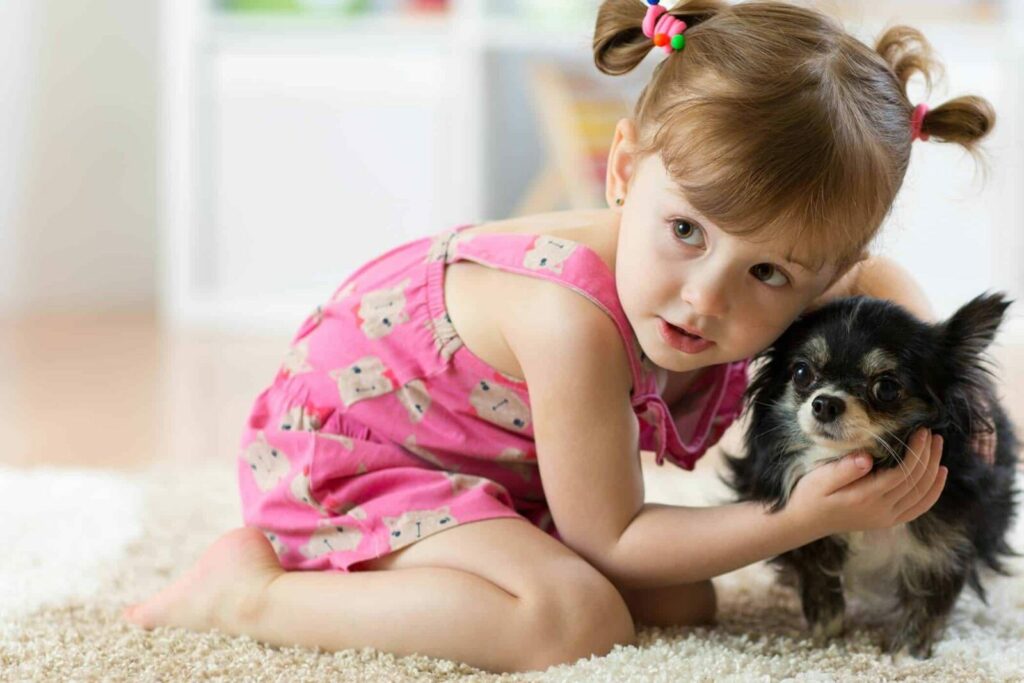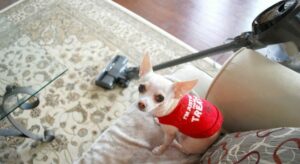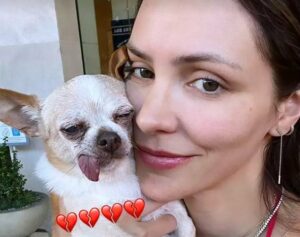Chihuahuas and babies are very cute on their own. But what happens if you bring them together?
Read on to find out:
- How your baby and your dog can traumatize each other (#4 is a must-read).
- The top 5 dangers of leaving your baby and Chihuahua together and unsupervised.
- 3 practical tips on how to make the interactions between your baby and Chihuahua fun and safe.
- And much more…
Table of contents [show]
Can Chihuahuas and babies live together?
Chihuahuas and babies can live together, but you have to get a lot of things right. Before having a baby, you need to change the environment early so your pet can get used to the new atmosphere. Introduce new sounds and objects to them and let them move around less freely.

5 risks of Chihuahuas and babies living together
#1: Pals that stay together, make noise together
Generally, dogs love noise because it indicates playtime. This can make them hyperactive and bark at inappropriate moments.
On the other hand, babies are noise machines that cry when they want something. Since dogs react to loud noise, the sound can annoy neighbors, especially in apartments.
Alternatively, a baby’s noise can catch a Chihuahua off-guard while they’re resting. This can make the Chi angry, stressed, or even anxious. Agitated barking will be their way of expressing displeasure.
If your baby is within earshot, your Chihuahua may start looking for your baby’s crib and express aggression when your pet sees them.
With these risks, it is important to:
Keep spaces separate
The closer your baby is to your Chihuahua, the more painful it can be for your dog. To keep them from bothering one another, put them in separate rooms.
Note: You can also put either your baby or your dog on the upper floor since stairs count as an obstacle for both. Have the stairs fenced before you do so!
Check for behavioral problems
Aggression and anxiety can be diagnosed months before you get a baby. Occasional visits to the vet are crucial to keep your dog in tip-top mental shape. You can also consult with a certified behaviorist.
Train your dog with baby sounds during pregnancy
Exposing them to baby sounds will make them think that the sound is perfectly normal later.
Note: Play games while the sound is playing in the background. This will reassure them that it’s okay to have fun despite the noise.
#2: Unsupervised touching is a health hazard
Babies tend to use all their senses – including touch – to know more about the environment around them.
Unfortunately, your Chihuahua is a sensitive pet. They will see your baby as a foreign object and can be stressed or frightened when touched.
The same is true for your baby. They can be frightened when your Chihuahua starts being aggressive, and your pet might bite or nip at your child.
This miscommunication can affect your baby and dog’s psychological health.
Here are some things you can do to prevent accidents:
Clean up
This cannot be emphasized enough – Chihuahuas can shed a lot within a year, especially during fall and spring. As you clean up, be sure to dust your baby off and prevent them from crawling on the floor to prevent ingestion.
Caution: You should also prepare first aid kits after playtime in case your baby gets hurt while playing.
Divide your attention equally
Both dogs and babies can become jealous when they’re not given attention. When playing together, try to multitask between your pet and baby.
Hold one of them while petting another. This way, you’ll be able to decide who touches whom.
Note: If you want to let your baby touch your pet, have them only pet their forehead and wipe your baby’s hands after.
Always clean up after playing together
Your baby might accidentally eat your Chihuahua’s fur or touch their droppings. When you’re finished playing, put your baby back in their crib and vacuum the floor.
Play at only one place around the house
If your Chihuahua is trained, then you should play near your baby’s crib. They will not only get used to their smell, but it’s also easier to put the baby away when playtime’s over.
Note: If your Chihuahua is still a puppy, carry the baby back to their crib first because your Chihuahua might shed while being held.
Don’t leave your baby and pet in the same place alone
Your dog may start roughhousing on your Chihuahua, and your baby might agitate them.
#3: Chihuahuas are curious and sneaky
Chihuahuas bring the idea of dog-proofing to a whole new level. The reason? They’re small and fast!
It’s harder to keep an eye out for them, especially if you’re distracted enough by your baby. This means that they can sneak up on your baby while you’re preparing the dishes or watching TV.
While preparing for your baby, you should already limit your dog’s space as much as you can. Here are some areas you should pay attention to:
Your room
If you want to spend more time with your baby, you need to dog-proof your room. If it’s on another floor, wall off the stairs. Keep small materials like jewelry or baby bottles inside cabinets.
Wrap sheets and clothing in plastic covers if you need to leave the house, so you can keep their poop and paws at bay. Keep wirings out of reach (if possible, hide them behind cabinets).
Note: If possible, put everything inside drawers, saving only lamps and other large materials that your Chihuahua can’t reach. They’re easily drawn to small things, so keep them away.
Living room
The most spacious part of your house can easily get caked with poop or pee. There are two ways you can approach this part of the house:
- Assign a specific space for your baby. Since toddlers often wander around the same spot, it’s possible for you to give them their space within the living room, such as on the couch or near the TV. Your dog can have the remaining open space until your baby’s ability to walk.
- Have your baby and dog take “shifts” in the living room. This can work because they have different body clocks. Chihuahuas tend to sleep during the afternoon, while babies are tuckered out during nighttime.
Dining room
Parents often eat with their children, so if you eat with your dog, you need to think about sealing off the dining room. Cover the seats and tables with slippery material like plastics to prevent them from clawing their way to you or your baby’s lap.
If you don’t have a door to block your dog’s movements, put one up. This will help keep your baby safe from your dog while eating dinner.
Note: It’s highly recommended that you train your Chihuahua to eat near their crate at this time. Place their bowl beside their crate, along with a used towel with your smell at the bottom. This can help with mild cases of separation anxiety.
Caution: If your Chihuahua has separation anxiety, play with them slightly after dinner!

#4: They can traumatize each other
Although Chihuahuas have dominant personalities, it’s possible for them to be traumatized by your baby.
This can happen if your Chihuahuas are still puppies, since they’re still taking in new knowledge about their surroundings.
When your baby pokes at your puppy too much or otherwise tosses them around like any toy, it can lead to your dog becoming scared of your baby.
Since they remember smells, it’s possible the fear might last well into their old age.
As for your baby, the same thing can happen. Chihuahuas are playful dogs, and will likely mistake your baby for a novelty toy if left alone.
Dogs nip and bite as part of playing. Thus, they can hurt your baby, cause infections or even a permanent fear of dogs.
This is why it’s always important to have a plan. For your dog, you’ll need to watch out for the following signs of trauma:
Whining
This is easily detectable because it will sound like your dog is screaming. When this happens, it means your baby has likely hurt them with something.
Yawning
Yawning is a coping mechanism for dogs. When they yawn, they see the baby as being aggressive. It also means that they’re stressed out and not willing to provoke anyone. Take away the baby from your dog when they show this sign.
Unprompted pooping
This appears in sudden situations. If they’re frightened enough, they may poop randomly on the floor. This is also a common symptom of separation anxiety.
If you see your dog frequently showing these signs around your baby, take them to the dog trainer or vet. It could mean psychological damage.
As for babies, you should take the following steps to prevent or help them overcome trauma:
Respond promptly to danger
Spur-of-the-moment situations like biting can rattle your baby at an early age. As one of the most common causes of cynophobia, you need to be around your baby when they get bitten.
Reassure them as you nurse their wounds. If necessary, spend the rest of the day with them. If bleeding does not stop immediately after applying first aid, call your local emergency hotline.
Stay up-to-date on vaccinations
Rabies shots for your baby and dog are not just effective at stopping the disease, it also puts your toddler at ease. This way, you can confidently tell them that nothing bad is going to happen after a bite.
Don’t be aggressive with your dog
Some owners may think of getting physical as revenge for their baby. Don’t do this as violence could scar both your dog and child.
If your dog gets too rough, simply take them away and have them spend time in open air while you nurse your baby.
Chihuahuas and babies
#5: They’re both expensive
Chihuahuas and babies require lots of attention. Together, they can be physically and financially taxing to handle
For starters, your Chihuahuas and babies can be awake at different times each day. This can cause problems if both of them want to nap.
You’ll need to make your own timetable for your baby and dog to help manage this. Base it on the following:
Alertness
Chihuahuas are especially alert during the morning, while babies can be alert before their afternoon nap. Go for walks with your pet during the morning and dote on your baby during midday.
If you can take 10-15 minute power naps in-between playtimes, do it. It will help you destress during the day.
Note: It’s always best to hire a sitter in this situation. You might not be able to tend to both because of work or other concerns, so getting extra help is necessary. Just beware of the added costs!
Nap times
Dogs spread their naps throughout the day and are active at night. Babies also do the same until at least 9 months when their sleep patterns start to stabilize.
Weather conditions
Chihuahuas are best taken out at 60-65°F (15-18°C) and can withstand outdoor temperatures of up to 90°F (32°C). The weather is most friendly to them during sunrise and late afternoons, so walk them accordingly with those times if possible.
If the temperature’s bad for your dog, let them stay indoors and divide your attention between your child and dog.
Another reason for high costs is dog allergies. Depending on how severe the reaction is, you might have to visit the ICU and pay high medical costs.
You also need to give your child and dog shots to prevent diseases like rabies from becoming a costly problem.
Note: It’s best to set up insurance before you start taking care of both. It will help cover medical costs and free your finances for other concerns.
If you want to take care of both a Chihuahua and a baby, you need to commit yourself financially and physically. Taking care of both can be costly for all of its rewards.
Don’t cut costs or lower the quality of your care, because their safety means your family’s safety as well.
3 tips to introduce your Chihuahua and baby (and make sure that they get along safely)
#1: Use commands
Before you introduce your Chihuahua to your baby, you need to teach your pet essential commands.
These commands can take months to master, so be sure to train during pregnancy. You can also hire a trainer if you’re not able to train your dog fully.
Here are some essential commands your dog needs to pick up along the way:
Stay
This is a staple of all dog owners. It tells your Chihuahua to stand still for a few moments. You can use this command when moving your baby from one place to another during playtime.
Note: Chihuahuas are active dogs, so don’t hold them down too often with this command. Try using a long leash if you want to limit their movement for extended periods.
Crate
This command will tell your Chihuahua to go back inside their crate and rest up. This is useful for keeping them away. Be sure to put a treat inside the kennel for better results.
Quiet/Speak
Quiet and Speak are commands that go together. You want to focus on “Quiet,” since it will help your baby rest. It will also help keep the noise down.
Note: To teach this command, have your dog bark by saying “speak” and giving them a treat. Then tell them “Quiet” while they’re barking. Give them a treat when they become silent. Rinse and repeat until they know the difference.
Here’s an example of a pro nailing obedience training:
#2: Smelling is caring
Chihuahuas interact with their environment by smelling things.
Naturally, you want them to get used to “baby scents” before you introduce the baby. This includes lotions, wipes, baby powder and even diapers.
Place your baby materials in front of your Chihuahua for smelling each day. You can also apply some on your skin and have your dog smell those.
If they find the scent too strong or similar, change it to something lighter. Don’t push your dog to like it, since it can only stress them out.
Caution: Stick to the same tools as much as possible. New scents might bother your Chihuahua and interrupt their training. Plan your products and stick to the same things as much as possible.
Doing so will let them know that your baby is completely safe. Once the baby is born, you can have them smell from a safe distance.
Chihuahuas have a strong sense of smell, so it’s okay to have them sniff your baby at arm’s length.
Note: It’s important not to get them too close. Your baby might accidentally boop your dog, causing discomfort on their part. It can also be dangerous to your baby’s health.
#3: Long introductions are better, literally
The younger your baby, the farther they should be from your Chihuahua.
Babies are touchy. They might poke parts that your Chihuahua might consider sensitive, such as their mouths or eyes.
Similarly, Chihuahuas love to play with their mouths. Owners and babies who are really close to their Chihuahua will be licked regularly.
Unfortunately, only owners will remember to wipe off the saliva. Thus, it’s safer to stay far from one another if they’re in the same space. To be safe, use a leash or tape measure as your guide.
The minimum distance between your baby and dog should be more than half a leash (3 feet or more). But you should keep them 6 feet away to be safe.
Note: Be sure that it’s spacious so there’s room for your Chihuahua to wander around if they’re having problems. The living room is a perfect spot for introductions.
But in the last, Chihuahuas and babies together, are very special for every family.




